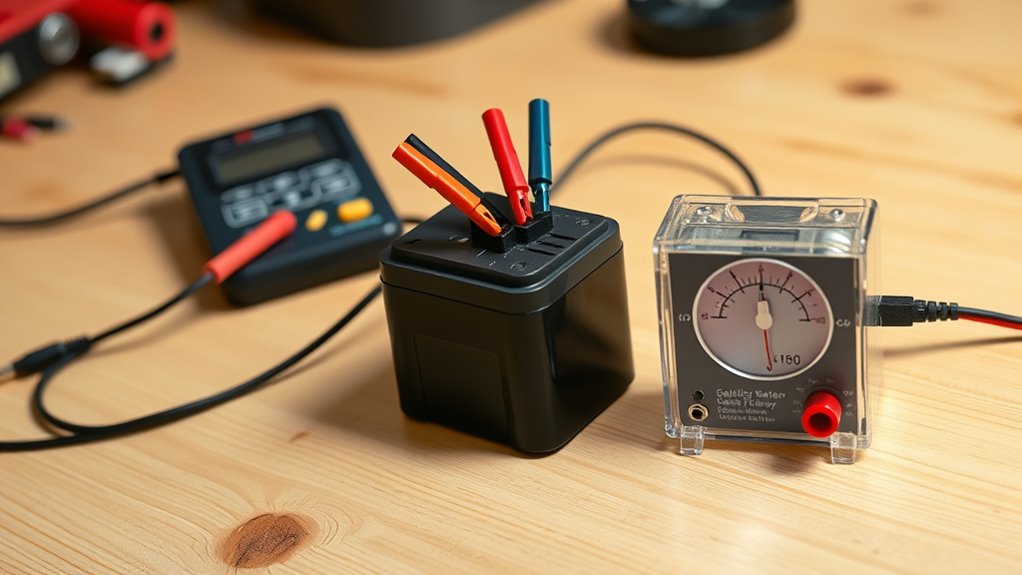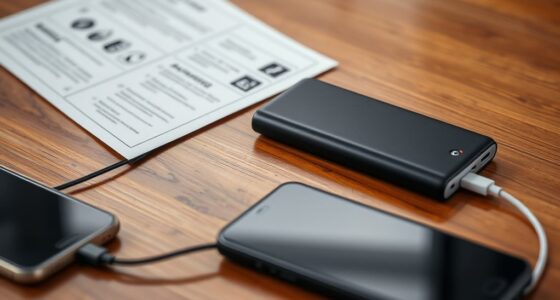To DIY load test your battery’s true capacity, you can use simple tools like a multimeter and a known resistor or small load device. First, measure the voltage before applying the load, then run the device under load while observing the voltage drop. A sharp decline or voltage falling below a certain level indicates capacity loss. Curious about more precise methods? Keep going to discover easy ways to evaluate your battery’s health effectively.
Key Takeaways
- Use a multimeter to measure voltage before and during a load to assess battery performance.
- Connect a known resistor or small appliance as a load to simulate real-world use.
- Record voltage drops and time until voltage reaches a critical level for accurate capacity evaluation.
- Ensure load resistance is appropriate to prevent excessive stress and inaccurate readings.
- Regularly perform load tests to detect capacity decline and determine optimal battery replacement timing.

Ever wondered how to make sure your website can handle high traffic without breaking the bank? While this question usually relates to web servers, the same concept applies to your batteries, especially if you rely on them for portable devices, solar setups, or backup power. Knowing your battery’s true capacity is essential, and that’s where DIY load testing comes into play. By understanding battery health and using simple testing methods, you can accurately assess how well your battery performs under real-world conditions, saving you money and preventing unexpected failures.
First, it’s vital to understand that battery health directly impacts its performance. Over time, batteries degrade due to repeated charge and discharge cycles, temperature fluctuations, and age. A degraded battery won’t hold as much charge as when it was new, which could lead to unexpected power loss or device shutdowns. To keep tabs on your battery’s health, you need to use effective testing methods. One straightforward approach is to perform a load test—running the battery under a controlled load and measuring how long it supplies power. This simple test can reveal if your battery is still capable of providing the necessary current or if it’s starting to fail.
Conducting a basic load test doesn’t require expensive equipment. You can use a multimeter to monitor voltage before and during the test. Connect a known load—like a resistor or a small appliance—and note the voltage drop over a specific period. If the voltage drops sharply or falls below a certain threshold, it indicates your battery might be losing capacity. For more accuracy, you might also record the time it takes for the voltage to fall to a critical level. This testing method gives you a real-world view of your battery’s ability to handle typical demands, rather than relying solely on static measurements like voltage when idle. Additionally, understanding how contrast ratio affects your projector’s image quality can help you optimize your viewing setup for the best experience. Regularly testing your battery’s health helps you catch early signs of deterioration. If your tests show declining capacity, it’s a sign to consider replacing the battery before it fails completely. Performing these tests periodically is an excellent way to stay ahead of potential issues, especially if your device or system depends heavily on battery performance.
Frequently Asked Questions
How Often Should I Perform Load Testing on My Batteries?
You should perform load testing on your batteries regularly to guarantee peak performance. Typically, testing frequency depends on your usage and battery age, but a good rule of thumb is every 3 to 6 months for maintenance. Consistent testing helps catch potential issues early, allowing you to address problems before they cause failure. Incorporate testing into your overall battery maintenance routine to keep your batteries reliable and long-lasting.
What Safety Precautions Are Necessary During DIY Load Testing?
Imagine you’re a knight preparing for battle—safety gear is your armor. During DIY load testing, you must wear gloves and eye protection to prevent sparks or acid splashes. Make certain proper ventilation to avoid harmful fumes, just like opening windows in a smoky tavern. Never overload the battery beyond its capacity, and keep a fire extinguisher nearby. These precautions keep you safe while accurately testing your battery’s true capacity.
Can Load Testing Damage My Batteries?
Load testing can potentially damage your batteries if not done properly, affecting their lifespan. To guarantee load testing safety, use the correct tools and follow manufacturer guidelines carefully. Overloading or testing for too long can strain your batteries, leading to reduced capacity or failure. Always monitor the process closely, and avoid excessive loads to protect your batteries’ health and extend their lifespan. Proper technique is key to preventing damage.
What Are the Signs of a Failing Battery After Load Testing?
Did you know that over 50% of battery failures are caused by poor charging habits? After load testing, you might notice signs like decreased runtime, frequent recharging, or battery corrosion around terminals. These symptoms indicate your battery’s capacity is declining. If you see corrosion or inconsistent performance, it’s a sign to review your charging habits and consider replacing the battery to avoid sudden failures.
Is Professional Load Testing More Accurate Than DIY Methods?
Professional load testing is generally more accurate because it uses laboratory accuracy and professional equipment. You might get more precise results with this approach, especially for critical applications. DIY methods can give you a good estimate, but they often lack the precision and consistency of professional tools. If you’re evaluating a high-stakes or complex battery, investing in professional testing ensures you get the most reliable data.
Conclusion
Now that you’ve learned how to DIY load test your battery, you’re armed with a simple tool to uncover its true capacity. Think of it as giving your battery a health check-up—like a doctor for your power source. With just a few basic tools, you can prevent unexpected failures and keep your gadgets running smoothly. Remember, a healthy battery is the backbone of reliable performance, so give it the care it deserves and stay powered up!










